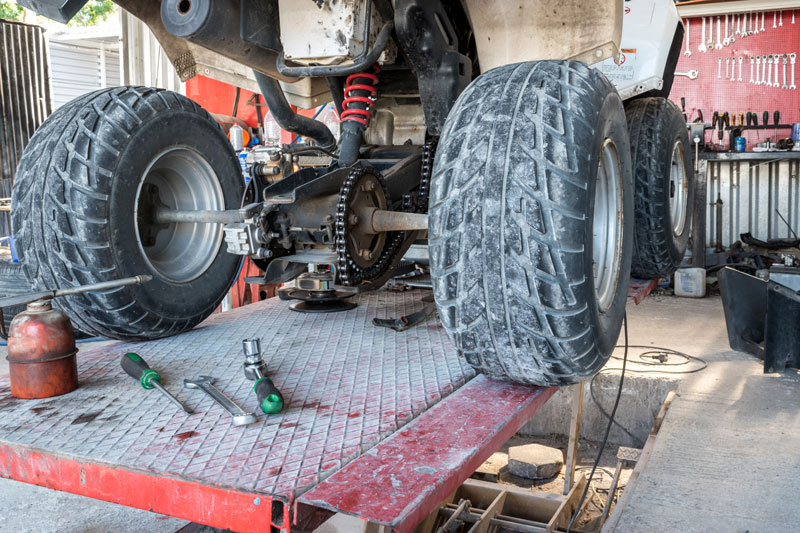ATV Happiness: Discover the Ultimate Off-Roading Experience
Wiki Article
ATV Riding Techniques: Understanding the Art of Off-Roading

Body Positioning
To effectively navigate with challenging off-road terrain, it is crucial for ATV riders to regularly keep appropriate body positioning. Preserving the proper body placement while riding an ATV not only enhances control and security but additionally makes certain the biker's safety. By embracing the appropriate body positioning methods, motorcyclists can efficiently disperse their weight, boost their equilibrium, and decrease the danger of injuries or crashes.One key aspect of correct body placing is maintaining the feet on the foot secures. Placing the feet on the foot fixes enables the motorcyclist to maintain security and control over the ATV. The rider's knees need to be slightly curved, supplying a slight suspension to take in shocks and preserve balance. Furthermore, the motorcyclist's upper body need to remain relaxed and versatile, permitting seamless and quick movements when necessary. This includes keeping a light grasp on the handlebars to preserve control without too much force.
In addition, the motorcyclist's eyes should constantly be concentrated ahead, scanning the terrain and preparing for any challenges or adjustments in the trail. By maintaining an ahead stare, motorcyclists can make split-second choices and respond suitably to testing surface.
Throttle Control
Building upon the value of correct body placing for ATV riders, understanding throttle control is an important skill that allows bikers to effectively steer via different off-road surfaces. Strangle control describes the capability to regulate the quantity of power supplied to the ATV's engine. By comprehending how to manipulate the throttle, riders can make sure a smooth and controlled acceleration, permitting them to browse barriers with accuracy.Among the basic elements of throttle control is discovering to regulate the throttle smoothly. Sudden or jerky motions can cause the ATV to lose grip or come to be unpredictable, making it tough to keep control. Instead, riders ought to aim for gradual and deliberate throttle inputs, particularly when passing through tough terrains. This method allows the ATV to keep a consistent rate and provides better grip, reducing the risk of crashes.
Along with smooth modulation, riders need to also discover just how to balance the throttle with other riding techniques, such as body positioning and braking. When climbing steep hills, motorcyclists require to use sufficient throttle to preserve momentum without subduing the ATV or creating wheel spin. When descending high slopes, bikers must use the throttle in combination with proper body positioning and braking to maintain control and avoid the ATV from gliding or tipping over.

Braking Methods
An important facet of ATV riding techniques is mastering reliable braking techniques. When it pertains to off-roading, understanding how to brake correctly can make a significant difference in your safety and security and control over the car. One of one of the most vital braking techniques is utilizing the front brake greater than the rear brake. The front brake supplies the bulk of the quiting power, so it is essential to use it judiciously. Nonetheless, it is necessary to keep in mind that extreme braking with just the front brake can trigger the look at these guys ATV to pitch ahead, possibly bring about loss of control or even turning over. Consequently, it is suggested to apply both brakes concurrently, but with more stress on the front brake. One more vital strategy is to avoid securing the wheels while stopping. Securing the wheels can cause skidding, making it hard to preserve control. To stop this, press the brake levers slowly and launch them a little if you really feel the wheels locking. By grasping these braking techniques, you can improve your ATV riding skills and make certain a delightful and secure off-roading experience.Cornering Methods
One important facet of understanding ATV riding strategies is recognizing reliable cornering methods. Cornering on an ATV can be difficult, but with the right techniques, motorcyclists can navigate turns securely and efficiently. The trick to effective cornering is to preserve control of the ATV while optimizing grip and reducing the risk of tipping over.To carry out article an appropriate cornering strategy, bikers need to come close to the turn at a proper rate, guaranteeing they are not going also slow-moving or as well quick. It is critical to move the body weight in the direction of the within the turn, leaning right into it to maintain equilibrium and stability. This assists for the centrifugal force and keeps the ATV upright.
Furthermore, bikers need to maintain their eyes concentrated on the leave point of the turn instead of the prompt course ahead (ATV). This permits smoother and more specific steering, as it aids the cyclist expect any barriers or changes in terrain
Moreover, correct throttle control plays a considerable role in cornering. Bikers should modulate the throttle efficiently, avoiding unexpected velocities or slowdowns, which can trigger loss of control.
Uphill and Downhill Riding
When navigating off-road terrain, ATV cyclists should grasp the methods for uphill and downhill riding to preserve control and guarantee safety. Downhill riding, on the other hand, needs cyclists to lean back and change their weight towards the rear of the ATV. By mastering the techniques for uphill and downhill riding, ATV cyclists can with confidence take on numerous off-road surfaces and enjoy a electrifying and secure experience.Final Thought
Finally, grasping the art of ATV riding calls for a combination of body positioning, throttle control, stopping methods, and reliable cornering. Uphill and downhill riding also need specific abilities to navigate safely. By applying these methods, motorcyclists can enhance click to find out more their off-roading experience and enhance their overall control and safety on the ATV.ATV Riding Techniques: Grasping the Art of Off-Roading is a comprehensive overview that digs right into the complexities of understanding the abilities required for off-road ATV riding. Whether you are a newbie or a seasoned motorcyclist, ATV Riding Techniques: Grasping the Art of Off-Roading offers indispensable advice to help elevate your off-road ATV riding abilities to the following level.

Report this wiki page